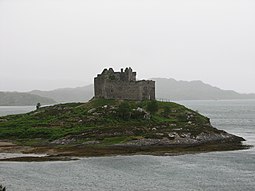Tioram Castle
| Gaelic name | Eilean Tioram |
|---|---|
| Meaning of name | dry island |
 |
|
| Location | |
|
Eilean Tioram shown within Lochaber
|
|
| OS grid reference | NM662724 |
| Coordinates | 56°47′N 5°48′W / 56.78°N 5.8°W |
| Physical geography | |
| Area | <2 ha |
| Highest elevation | 10 metres (33 ft) |
| Administration | |
| Sovereign state | United Kingdom |
| Country | Scotland |
| Council area | Highland |
| Demographics | |
| Population | 0 |
| References | |
Castle Tioram (/ˈtʃiːrəm/) (Scottish Gaelic: Caisteal Tioram, meaning "dry castle") is a ruined castle that sits on the tidal island Eilean Tioram in Loch Moidart, Lochaber, Highland, Scotland. It is located west of Acharacle, approximately 80 km (50 mi) from Fort William. Though hidden from the sea, the castle controls access to Loch Shiel. It is also known to the locals as "Dorlin Castle". The castle is a scheduled monument.
The castle appears to have originally been a principal stronghold of Clann Ruaidhrí. Eilean Tioram, the island the fortress sits upon, is first recorded in a charter of Cairistíona Nic Ruaidhrí (fl. 1290–1318), daughter of Ailéan mac Ruaidhrí (died ×1296). According to early modern tradition, preserved by the seventeenth-century Sleat History, the castle was erected by Ailéan's granddaughter, Áine Nic Ruaidhrí (fl. 1318–50). The castle certainly served as the seat of the latter's Clann Raghnaill descendants for centuries.
As such, Castle Tioram is the traditional seat of the Clanranald (Clann Raghnaill) branch of Clan Donald. The castle was seized by Government forces in around 1692 when the clan chief Allan MacDonald of Clanranald joined the Jacobite Court in France, despite having sworn allegiance to the British Crown. A small garrison was stationed in the castle until the Jacobite rising of 1715 when Allan recaptured and torched it, purportedly to keep it out of the hands of Hanoverian forces. It has been unoccupied since that time, although there are some accounts suggesting it was partially inhabited thereafter including for the storage of firearms from the De Tuillay in the 1745 Jacobite Uprising and Lady Grange's account of her kidnapping.
...
Wikipedia

